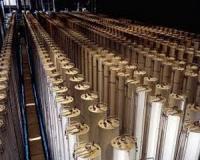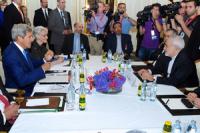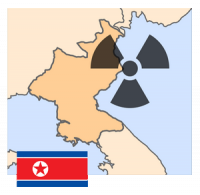-
Tweet May Have Inadvertently Revealed India’s Next-Gen Nuclear Weapons Platform with Global Reach
Politicians’ tweets can sometimes reveal new intelligence about their own country’s military capabilities and programs. On August 28 the official Twitter account of the Vice President of India, Shri M. Venkaiah Naidu, tweeted photos of his visit to the country’s Naval Science & Technological Laboratory. Among the missiles and unmanned vehicles is a sub-scale model of a submarine. And it appears to be not just any submarine – the model may offer the first visual clues to India’s next-generation ballistic missile submarine, the S-5 Class.
-
-
Iran Threatens to Take Steps to Stockpile of Uranium for Nuclear Weapons
Iran said Saturday it had accelerated its nuclear research work and threatened to take fresh steps within a month that could allow it to expand its stockpile of enriched uranium, a material that can be used to fuel a nuclear weapon. The move comes after Europe failed to meet a deadline Iran set in July to offset the impact of U.S. sanctions.
-
-
North Korea Missile Tests, “Very Standard” to Trump, Show Signs of Advancing Arsenal
As North Korea fired off a series of missiles in recent months — at least 18 since May — President Trump has repeatedly dismissed their importance as short-range and “very standard” tests. And although he has conceded “there may be a United Nations violation,” the president says any concerns are overblown. Kim Jong-un, North Korea’s leader, Mr. Trump explained recently, just “likes testing missiles.” American intelligence officials and outside experts have come to a far different conclusion: that the launchings downplayed by Mr. Trump, including two late last month, have allowed Mr. Kim to test missiles with greater range and maneuverability that could overwhelm American defenses in the region.
-
-
Iranian Nuclear Facility “Has Never Been Repurposed” as Promised under 2015 Nuclear Deal
Iran’s underground Fordow uranium-enrichment facility has not followed the 2015 nuclear deal. Apparently, it has “never been repurposed” in that “everything required to enrich uranium to weapons grade could be quickly reconstituted in the underground portion of the facility,” continued the report.
-
-
How Israel and Iran Joined Forces to Kill a Nuclear Weapons Program
At dawn on 30 September 1980 four American-made F-4E Phantom jets screamed low over central Iraq, each laden with air-to-air missiles and three thousand pounds of bombs. The skimming Phantoms climbed briefly to higher altitude so as to appear on Iraqi radars, before ducking back down to hit the deck. But while two decoy Phantoms maintained their trajectory towards Baghdad, the other two veered southwards towards the real target: Iraq’s Osirak light-water nuclear reactor. The jets were undertaking the first air-strike against a nuclear reactor, and the first preemptive air-strike attempting to prevent a country from developing nuclear weapons capability. Now, the famous Israeli Operation Opera that destroyed the Osirak reactor was still nine months away. The Phantoms soaring towards the reactor in 1980 belonged to the Iranian Air Force.
-
-
The State of the Deal: How the Numbers on Iran's Nuclear Program Stack up
When it comes to the state of the Iran nuclear deal, there are enough figures flying around to make your head spin like atoms in a first-generation gas centrifuge. Here’s a little guide to help you keep track of the score.
-
-
IAEA confirms Iran enriching uranium in excess of 2015 nuclear deal limit

The United Nations atomic watchdog agency has confirmed that Iran has surpassed the limits on how much it was allowed to enrich uranium under the 2015 international nuclear deal. The International Atomic Energy Agency said its inspectors verified Monday that Iran has passed 4.5 percent enrichment, breaching the 3.67 percent limit set in the accord aimed at restraining Tehran’s nuclear weapons development.
-
-
Iranian enriched uranium limit breached, IAEA confirms
The International Atomic Energy Agency (IAEA) confirmed Monday that Iran has surpassed the stockpile of low-enriched uranium allowed under the 2015 nuclear accord with world powers, known as the Joint Comprehensive Plan of Action (JCPOA).
-
-
Rectifying a wrong nuclear fuel decision
In the old days, new members of Congress knew they had much to learn. They would defer to veteran lawmakers before sponsoring legislation. But in the Twitter era, the newly elected are instant experts. That is how Washington on 12 June witnessed the remarkable phenomenon of freshman Rep. Elaine Luria (D-Norfolk), successfully spearheading an amendment that may help Islamist radicals get nuclear weapons. The issue is whether the U.S. Navy should explore modifying the reactor fuel in its nuclear-powered vessels — as France already has done — to reduce the risk of nuclear material falling into the hands of terrorists such as al-Qaida or rogue states such as Iran. Luria says no. Alan J. Kuperman writes in the Pilot Online that more seasoned legislators have started to rectify the situation by passing a spending bill on 19 June that includes the funding for naval fuel research. They will have the chance to fully reverse Luria in July on the House floor by restoring the authorization. Doing so would not only promote U.S. national security but teach an important lesson that enthusiasm is no substitute for experience.
-
-
Iran’s WMD; the Kremlin’s 2020 strategy; DHS assessment of foreign VPNs, and more
· Iran seeking to expand military program to weapons of mass destruction: German intelligence
· The Kremlin’s strategy for the 2020 U.S. election: Secure the base, split the opposition
· Countering Russia’s malign influence operations
· Mueller: My hands were tied on charging Trump
· Federal cybersecurity agency on the way?
· DHS assessment of foreign VPN apps finds security risk real, data lacking
· Sunk costs: The border wall is more expensive than you think.
· Florida 2019 hurricane season opens with lessons from Matthew, Irma, Michael
· Mayors appear increasingly concerned about infrastructure
-
-
Iran officially begins unlimited production of enriched uranium, heavy water
Iran has officially ended its compliance with several commitments under the 2015 nuclear accord, an informed official in the country’s atomic energy body told local media channels on Wednesday.
-
-
Iran suspending some nuclear deal commitments

Iranian President Hassan Rouhani announced Wednesday his country will suspend its compliance with prohibitions on stockpiles of enriched uranium and heavy water that were imposed as part of the 2015 international agreement on its nuclear program.
-
-
Second edition of Nuclear Nonproliferation Textbook
Brookhaven Lab has updated and published the second edition of the Nuclear Nonproliferation Textbook, originally published in 2013. The new release describes important changes that have since been implemented in the International Atomic Energy Agency’s (IAEA) safeguards system for the peaceful use of nuclear energy and documents the IAEA’s verification role in Iran that began in 2015.
-
-
U.S. should reject partial North Korean “concessions”: Experts

The failure to reach an agreement at last week’s Hanoi meeting between President Donald Trump and the North Korean leader Kim Jong-un in Hanoi is but the latest indication that the differences between the United States and North Korea over the latter’s nuclear weapons capability are deep and complex.
-
-
Better monitoring of nuclear power plants, nuclear proliferation
The United Kingdom is investing nearly £10 million (about $12.7 million) in a joint project with the United States to harness existing particle physics research techniques to remotely monitor nuclear reactors. Expected to be operational in 2024, the Advanced Instrumentation Testbed (AIT) project’s 6,500-ton detector will measure the harmless subatomic particles called antineutrinos that are emitted by an existing nuclear power plant 25 kilometers, or about 15.5 miles, away.
-
- All
- Regional
- Water
- Biometrics
- Borders/Immig
- Business
- Cybersecurity
- Detection
- Disasters
- Government
- Infrastructure
- International
- Public health
- Public Safety
- Communication interoperabillity
- Emergency services
- Emergency medical services
- Fire
- First response
- IEDs
- Law Enforcement
- Law Enforcement Technology
- Military technology
- Nonlethal weapons
- Nuclear weapons
- Personal protection equipment
- Police
- Notification /alert systems
- Situational awareness
- Weapons systems
- Sci-Tech
- Sector Reports
- Surveillance
- Transportation
Advertising & Marketing: advertise@newswirepubs.com
Editorial: editor@newswirepubs.com
General: info@newswirepubs.com
2010-2011 © News Wire Publications, LLC News Wire Publications, LLC
220 Old Country Road | Suite 200 | Mineola | New York | 11501
Permissions and Policies
Editorial: editor@newswirepubs.com
General: info@newswirepubs.com
2010-2011 © News Wire Publications, LLC News Wire Publications, LLC
220 Old Country Road | Suite 200 | Mineola | New York | 11501
Permissions and Policies
